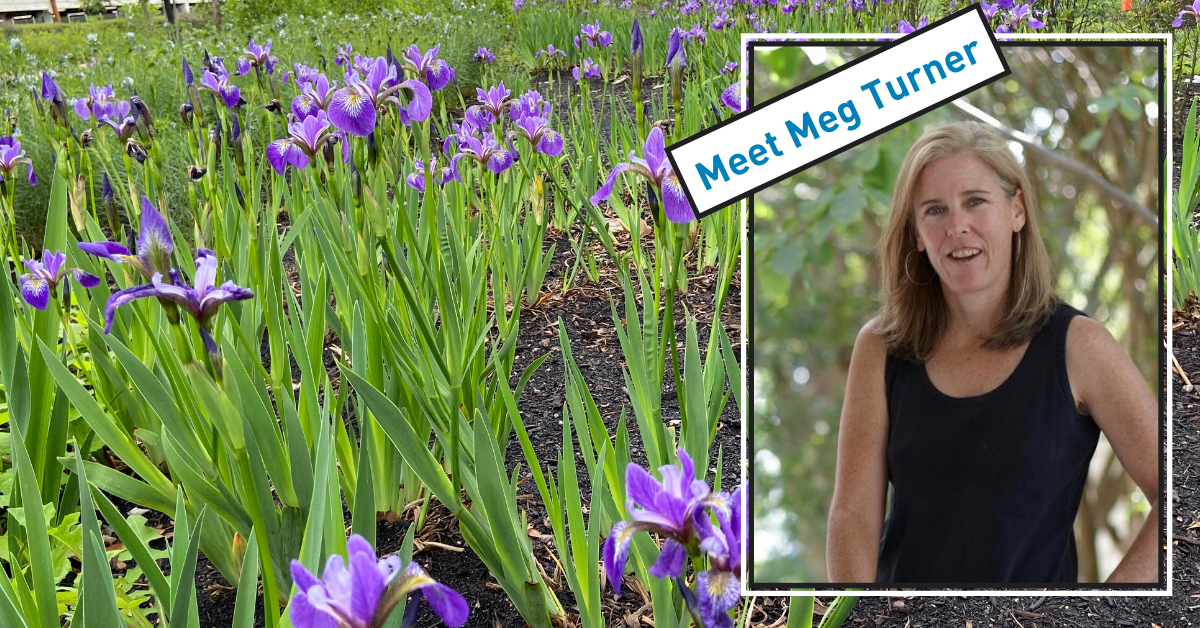
Most days Capital Trees focuses on the plants they’ve added and the projects they’ve implemented throughout Richmond. Because that’s the primary focus after all. Working to connect people to nature and bringing more green spaces to the City. But, as you can probably imagine, there are people hard at work behind the scenes to create, fund, and maintain projects.
One of those people? Meg Turner. Chair of the Board. Landscape designer. Founding member of Capital Trees. Gardening guru. Negotiating aficionado. One title just wouldn’t be enough.
She became the Chair of our Board of Trustees in July of 2019. We spent a little time chatting with her to learn more about her involvement with Capital Trees to date, and where she’s helping to lead the organization going forward.
Some folks find a love of nature through gardening with their parents, but Meg got where she is in a more roundabout fashion. An interest in gardening was planted during summer visits with her grandmother. But as a profession, Meg originally practiced law. It wasn’t until she moved to Richmond nearly 30 years ago that she created her first garden. A few years later, she joined the James River Garden Club and one thing led to another. Meg went on to study landscape design and then built a business designing gardens around town.
Four of Richmond’s garden clubs (James River, Tuckahoe, Boxwood and Three Chopt) came together in 2010 to take on the 14th Street Initiative. The project became Capital Trees’ first contribution to the City. During the completion of this project, Meg served as a liaison to the City of Richmond. Then, she was part of the team that helped Capital Trees revive Great Shiplock Park, and create the Low Line and Low Line Green.
Along with other organizations in Richmond, Capital Trees has helped to put the importance of urban green space on the map. In the next year, Meg is excited to see the impact that the Mayor’s newly created “Green Team” will have. Capital Trees has earned a spot as an advisor in this group. The organization will offer guidance for the new green spaces throughout Richmond.
In the past, Meg has been primarily involved in the project side of Capital Trees’ work. But, she knows that there can’t be projects without a strong development team in place. Meg is grateful for and works closely with Capital Trees’ Executive Director, Frazier Armstrong, to continue to build and secure relationships with community partners. And she’s learned quite a bit from her predecessor, Susan Robertson, who she referred to as a “phenomenal development person and an incredible leader.”
While it’s clear that Capital Trees sees, assesses, and tackles challenges that come before it, there’s still work to be done. Residents benefit from the beautiful green space, they jog along the Low Line, some people visit every day. But, they still don’t know that Capital Trees exists. And for a group that relies heavily on private donors, it’s imperative that people start to understand that Capital Trees is an organization that’s advocating on their behalf.
One of Meg’s goals for her time as Chair is to help ensure that public landscapes are prioritized as part of Richmond’s policy and planning. The pandemic has drawn attention to the importance of green space in our communities — to connect with nature, exercise, find solace. A grassroots organization from the start, Capital Trees has accomplished a great deal in a short period of time (see their projects to date). But to ensure that green spaces are more and more available to all Richmonders – that takes a village. And Meg, and the rest of the team working tirelessly behind the scenes at Capital Trees, have been integral to building, nurturing and maintaining the village that has accomplished so much already.
————————
Got a little time and hankering to get your hands dirty? We also picked Meg’s brain about some of her favorite plants along the Low Line. Perfect for if you’d like to bring a little of the Low Line home with you.
Q. What’s your favorite plant along the Low Line?
A.“I would say the Blue Flag Iris. I think it’s beautiful, it adds structure, it’s native, and it’s a workhorse down there. We have a lot of drainage issues and it thrives… It’s the gift that keeps on giving. I’m hoping that we can divide some of those Iris and maybe use them at the Low Line Green.”
If you’d like to plant it yourself, look for Iris versicolor, Blue Flag Iris.
Q. What’s the most multi-functional plant along the Low Line – the MVP?
A.“The Winterberry. It does well, there’s four seasons of interest… It’s got it all.
It’s beautiful, it’s hardy, it’s native, it provides food for wildlife.”
Want some at home? The botanical name is Ilex verticillata ‘Red Sprite.’ You must plant a male Ilex verticillata, such as ‘Apollo’ or ‘Jim Dandy’ in the vicinity for the females to fruit.

